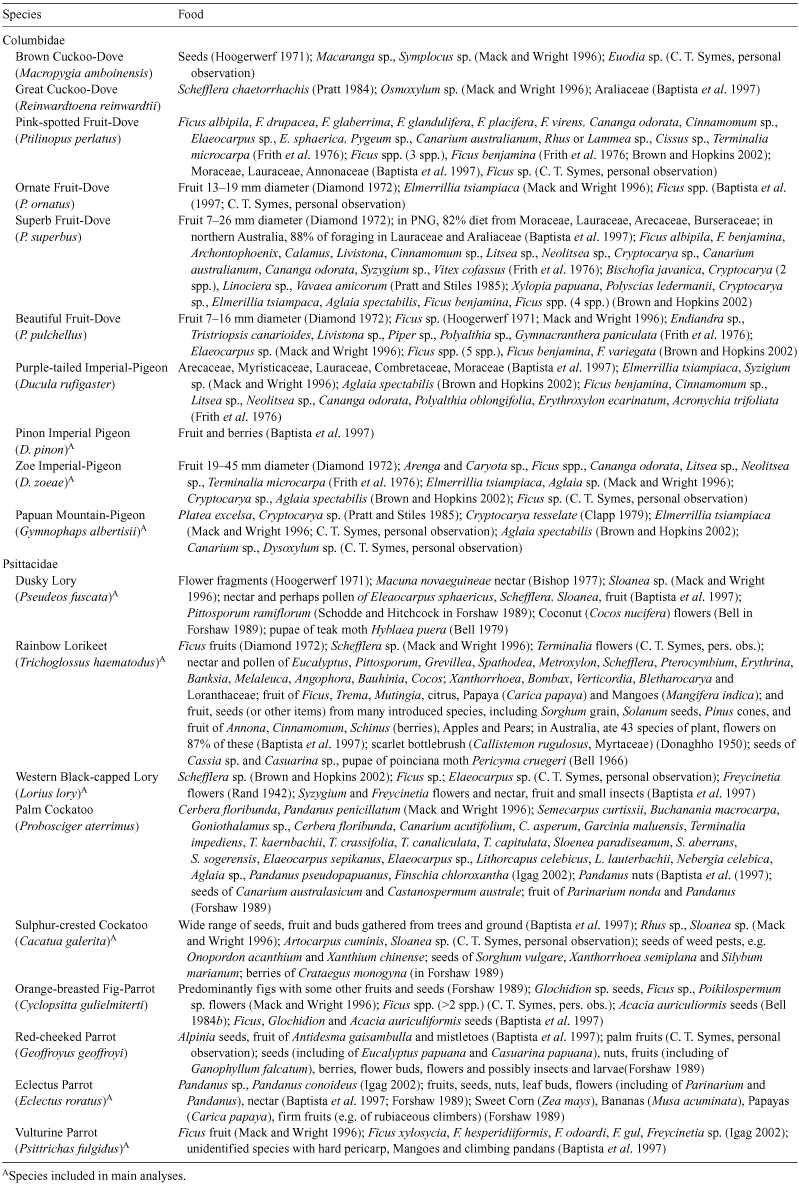Patterns of supra-canopy flight by pigeons and parrots at a hill-forest site in Papua New Guinea
Craig T. Symes A C and Stuart J. Marsden BA Department of Zoology and Entomology, University of Pretoria, Pretoria, 0002, South Africa.
B Department of Environmental and Geographical Sciences, Manchester Metropolitan University, Chester Street, Manchester, M1 5GD, England.
C Corresponding author. Email: craig.symes@zoology.up.ac.za
Emu 107(2) 115-125 https://doi.org/10.1071/MU06041
Submitted: 6 September 2006 Accepted: 5 April 2007 Published: 15 June 2007
Abstract
It is important that conservation strategies consider the needs of taxa that range over large areas or make significant daily or seasonal movements across areas or habitats, but data on movements in most tropical animal species is lacking. We examined frequency, direction, and temporal variation in supra-canopy flight activity (number of individuals recorded per hour of recording) of eight species of parrot and seven species of pigeon over 5 months in a New Guinean hill-forest. Papuan Mountain Pigeon (Gymnophaps albertisii) contributed 44% of all flights and Sulphur-crested Cockatoo (Cacatua galerita) 17%; while 95% of 1800 flights were made by seven species. Directions of flights were non-random in nearly all species. There was a significant movement of Papuan Mountain Pigeon, and smaller movements of Dusky Lory (Pseudeos fuscata), Rainbow Lorikeet (Trichoglossus haematodus) and Eclectus Parrot (Eclectus roratus), towards lower altitudes in the mornings and a varying return to higher altitudes in the afternoons. Most species made more supra-canopy flights in the mornings than the afternoons but the exact patterns of flight differed between species. Flight activity varied significantly between months in several species, and flight activity tended to be highest during periods of breeding in most frugivorous birds. Large-bodied species made more supra-canopy flights than did smaller species, but there was no relationship across species between ‘on-the-ground’ bird densities and flight-frequency. Breadth of frugivorous diet (determined by review of the literature) did not influence flight-frequency. The factors that underpin the highly variable patterns of movement were identified. How these patterns might be affected by changes in land-use is important for landscape-level conservation, especially for those species that make systematic long-distance movements.
Acknowledgements
The project was funded by the North of England Zoological Society and we thank Dr Roger Wilkinson for various help. The National Research Institute (NRI) and Department of Environment and Conservation (DEC) of Papua New Guinea are thanked for facilitating our research, and the Research and Conservation Foundation of Papua New Guinea (RCF) and Wildlife Conservation Society (WCS – Papua New Guinea Program) are thanked for their support throughout the study. We are particularly grateful to Andy Mack, Deb Wright and Ross Sinclair (WCS) for their invaluable help and kindness throughout the project. We thank the Pawaiian landowners of the area, and especially Ijenepe Houmole, Rocksy, and Sam and Tracy Young for assistance in the field. We are grateful to the anonymous referees whose comments improved this paper.
Bell, H. L. (1966). Some feeding habits of the Rainbow Lorikeet. Emu 66, 71–72.
Clapp, G. E. (1979). Mountain Pigeons Gymnophaps albertisii feeding on the large drupes of Cryptocarya tesselate in the Northern Province. Papua New Guinea Bird Society Newsletter 159(September), 2–4.
Corlett, R. T. (1998). Frugivory and seed dispersal by vertebrates in the Oriental (Indomalayan) Region. Biological Reviews 73, 413–448.
| Crossref | GoogleScholarGoogle Scholar | PubMed |
Diamond, J. , Bishop, K. D. , and Gilardi, J. D. (1999). Geophagy in New Guinea birds. Ibis 141, 181–193.
Frith, H. J. , Crome, F. H. J. , and Wolfe, T. O. (1976). Food of fruit-pigeons in New Guinea. Emu 76, 49–58.
Graham, C. H. (2001). Factors influencing movement patterns of keel-billed toucans in a fragmented tropical landscape in southern Mexico. Conservation Biology 15, 1789–1798.
| Crossref | GoogleScholarGoogle Scholar |
Holbrook, K. M. , and Smith, T. B. (2000). Seed dispersal and movement patterns in two species of Ceratogymna hornbills in a West African tropical lowland forest. Oecologia 125, 249–257.
| Crossref | GoogleScholarGoogle Scholar |
Kimura, K. , Yumoto, T. , and Kikuzawa, K. (2001). Fruiting phenology of fleshy-fruited plants and seasonal dynamics of frugivorous birds in four vegetation zones on Mt. Kinabalu, Borneo. Journal of Tropical Ecology 17, 833–858.
Lindsey, G. D. , Arendt, W. J. , Kalina, J. , and Pendleton, G. W. (1991). Home range and movements of juvenile Puerto Rican parrots. Journal of Wildlife Management 55, 318–322.
| Crossref | GoogleScholarGoogle Scholar |
Mack, A. L. , and Wright, D. D. (1996). Notes on occurrence and feeding of birds at Crater Mountain Biological Research Station, Papua New Guinea. Emu 96, 89–101.
Powell, G. V. N. , and Bjork, R. (1995). Implications of intratropical migration on reserve design – a case-study using Pharomachrus mocinno. Conservation Biology 9, 354–362.
| Crossref | GoogleScholarGoogle Scholar |
Renton, K. (2001). Lilac-crowned parrot diet and food resource availability: resource tracking by a parrot seed predator. Condor 103, 62–69.
| Crossref | GoogleScholarGoogle Scholar |
Willson, M. F. , Irvine, A. K. , and Walsh, N. G. (1989). Vertebrate dispersal syndromes in some Australian and New Zealand plant communities, with geographic comparisons. Biotropica 21, 133–147.
| Crossref | GoogleScholarGoogle Scholar | refer to size of fruits recovered from crops of collected specimens; for data from Brown and Hopkins (2002) the number of unidentified Ficus spp. is given. Some records may include data for Australian species (e.g. Baptista et al. 1997 and Collar 1997), although the presented information do not include records from Higgins (1999)


